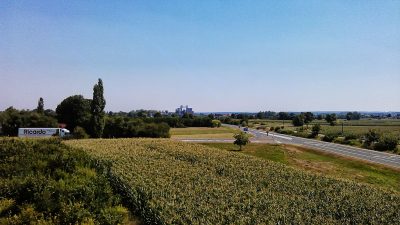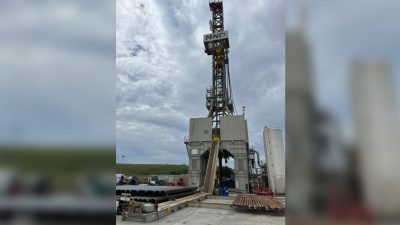San Francisco Geothermal Innovation & Investment part 1
Notes from the San Francisco Geothermal Innovation & Investment Conference, March 24-25, 2009
Currently, I am attending the Geothermal Innovation & Investment Conference here in San Francisco. The event is a two day event, organized by a U.K. based conference firm.
With this being probably one of the first “for profit” geothermal conferences, the crowd attending the event, is different than the usual conferences I have attended so far. With one or two bankers, the event is mostly seeing private equity players, developers, drilling companies, journalists and researchers, mostly from the U.S.
I am now going to give some kind of summary of the first day of the conference, but might end up writing a second part or even a third part after today’s conference continuation.
Keynote: The keynote of the event was given by Ed Wall, the program manager of the Geothermal Technologies Program at the U.S. Department of Energy (DOE). He highlighted the changes his department has seen in recent months and weeks. Basically, he said that “two years ago, the U.S. Department of Energy requested no money for geothermal technology and research and development, and its Geothermal Technologies Program office had a staff of four.
The office has doubled in size since last July, and the federal stimulus plan signed by President Obama last month has set aside $400 million for geothermal energy development. That’s on top of the $45 million Congress has allocated for this fiscal year for the DOE’s geothermal program (DOE asked for $35 million), Wall said.
“Looking at the renewable energy program, geothermal is the least understood,” said Wall at the Geothermal Innovation & Investment conference in San Francisco. “The fact that it’s underground source is at least part of that, and it requires the understanding of geology and engineering to access it.”
He hopes the new federal funding will encourage more new entrants into the industry. Oil and gas companies, for example, would be a nice fit because they already have some drilling and production technologies that can be modified for generating geothermal power, Wall said.” (quotes from an article of a journalist attending the meeting on greentechmedia.com)
Geothermal power and investment climate: The first session of the day then saw presentations and discussions with Mark Taylor of New Energy Finance and Charles Baron of Google.org.
Charles Baron is the geothermal program lead at Google’s charitable arm, Google.org. He talked about his organization’s investments in EGS technology and the firms AltaRock and Potter Drilling. He particularly stressed the fact of the current U.S. dependency on coal, which stands for 50% of the electricity generation in the country, but 84% of greenhouse gas emissions from electricity generation. The company has so far put US$ 10.8 million into EGS and maintains an informational website at google.org/egs.
Mark Taylor, U.S. based lead analayst for geothermal and clean coal of UK’s New Energy Finance, a renewable energy investment research company and formerly with the U.S. Geothermal Energy Association, gave his view on the investment climate for the industry. Basic message there is still investment into the industry, but currently no money coming from banks. Still with US$ 2.5 billion investments, the industry has seen a growth of 38% compared to the year before, but still is miniscule compared to the other renewables. He also quoted a survey done by New Energy Finance, which highlights that there is interest by private equity players in earlier stage investments and that there are a number of new equity players getting interested in the space.
In the panel discussion, both gentlemen were asked about how they would allocate the money the U.S. DOE got. The main message was here that drilling as a risk should somehow be addressed through R&D efforts, and that there has to be a balance between EGS and conventional geothermal. A topic hotly debated over dinner than last night.
Geophysical potential for geothermal energy: David Blackwell of the Geothermal Laboratory at Southern Methodist University (SMU) then gave his view on geothermal potential. While I had expected some numbers, he didn’t give much of specifics. But clear message was that there are limitations to the development of conventional geothermal (hydrothermal) and that EGS is going to be huge. He also referred to an article that was written on behalf of UN Intergovernmental Panel on Climate Change (IPCC). The article “The possible role and contribution of Geothermal Energy to the Mitigation of Climate Change (pdf 0.6 MB)” is a fantastic document highlighting the potential of geothermal in the whole climate change debate. [while not related, there are a number of fantastic presentations on sustainability in geothermal on the website of IEA, here]. Blackwell then continued talking about differences and potential of sedimentary projects (hot dry vs. hot wet rocks) and geopressured resources. He referred to that there is traditionally a lot of hot water is coming to the surface through oil exploration, something whih could potentially have a large utilization potential. As usual he also stressed that – from his point of view – that there needs to do more data collection and publication on geothermal potential in the U.S. to estimate the potential for geothermal, e.g. in the Eastern U.S.
Trends in Venture Capital and Equity Investments: The next round of presentations came from three players in the private equity/ venture capital field. Scott Makin of Denham Capital Management talked about his firm, that has a US$ 4.3 billion in its Private Equity fund. His company has invested US$ 145 million into U.S. development company Vulcan Power.
Trae Vasallo of Kleiner Perkins than talked bout her firm that has a US$ 2 billion invested in ventures across various sectors. The firm focuses on venture capital and she described how they ended up putting money into EGS and particularly into AltaRock working there with Susan Petty. AltaRock is working on a pilot project at The Geysers in California, using existing dry wells and then utilizing available infrastructure, e.g. power generation of underutilized available capacity in the nearby power plant.
Paul Ho of Hudson Clean Energy Partners, then talked about his 1 year old Private Equity firm with a US$ 825 million portolio to be put at work. Currently the company has invested into 4 firms, in solar and wind, but is very interested in the geothermal space. But he made very clear that the current investment climate makes existing operating assets cheaper than the cost to actually develop geothermal power projects, which clearly makes it hard to sell the idea of financing develoment. His company is therefore more interested in later stage investments helping companies to grow from an existing operating basis.
Well, this is the first round of notes from the conference, more will follow tonight or tomorrow.











